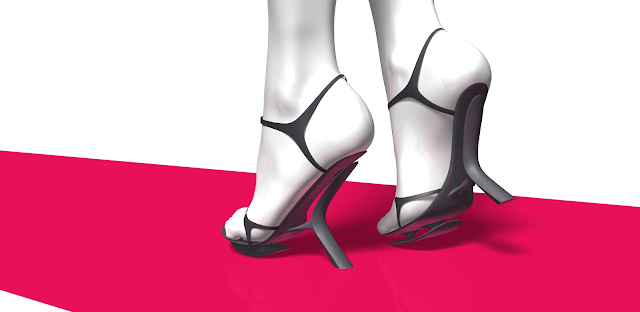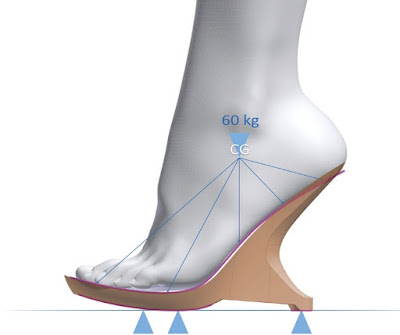HOW A MOVIE-STAR’S REQUEST FOR FABULOUS HEELS AT FASHION WEEK CAME TO A FAIRYTALE ENDING
THE CHALLENGE
Once upon a time, a top designer received an audacious request from a major movie star famed for her role as a modern-day Cinderella: make me a pair of unforgettable high heels to wear at the next fashion week so I can be the belle of the ball. You have two weeks!
This was the daunting challenge presented to designer Gray Holland, but it was a challenge he couldn’t refuse. His problem was that he had no real contacts with traditional manufacturing or shoe designers. And his concern was that “If the shoe breaks, the star loses face, and I might get sued”.
Gray knew what he wanted to create: fabulously innovative shoes whose aesthetics and structure intertwined perfectly and allow the long-legged, 60kg (about 130 pounds) celebrity to grace the red carpet with consummate ease.
“I imagined something so minimal, yet elevated. These magic heels would float her into the event, coyly daring to steal the show,” Gray dreamed.
“Images of organic form development, re-manmade—bones and sinew, branches and roots, coral colonies, rivers, and lightning flashed through my designer’s mind.
“Could I push the limits of physics and fashion at the same time, in only a couple of weeks?
Could I explore the limits of my ideas and fortify the design’s structural integrity at the same time?”
“Images of organic form development, re-manmade—bones and sinew, branches and roots, coral colonies, rivers, and lightning flashed through my designer’s mind.
“Could I push the limits of physics and fashion at the same time, in only a couple of weeks?
Could I explore the limits of my ideas and fortify the design’s structural integrity at the same time?”
Desperately seeking a fairy Design Software
With zero margins for error, but they need to try out new radical design ideas, his mind suddenly turned to a powerful engineering technology he had seen from Dassault Systèmes CATIA® a brand that is able to optimize structural forms and simulate forces and material properties; software that is used to invent ultra-light structures for aerospace and automotive projects. But could it really be the magic wand he was looking for to create the perfect pair of shoes? Gray was convinced that the need for total refinement and structural integrity for the high heels would be perfectly served by this technology.
The plan was to produce promising new forms, then feed these back into the system, creating “inspiration loops”, fresh simulations and unique final design ideas.
With Cinderella’s pumpkin nowhere in sight, Gray would have to turn to a state-of-the-art 3D carbon printer to conjure up a pair of prototype heels fit for the red carpet.
And there was an added challenge: while the designer had solid 3D modeling experience, he had only two days of available time to come to grips with the unfamiliar shape optimization software and produce results.
“Ok, I was a bit nervous,” he admitted.
Could 3D modeling software CATIA be the magic wand?
Gray knew that the software could simulate a given material’s structural integrity, and then reduce the object’s volume to a minimum, based on the forces at hand, thus removing any risk of breakage.
For his two-day “test drive”, he brought a simple set of “input forces” on which to explore shoe designs.
The first was the foot force bearing down on the shoe’s contact points on the ground, based on physical measurements and the center of gravity.
He also brought with his sketches of volume possibilities between the foot and the floor.
Switching between traditional sketches and spinning the organic-style results on the screen to view from every angle, Gray fine-tuned his approach, extracting yet more volume. In this feverishly creative exercise, he sensed he was on the verge of discovering new and unconventional treasures in shoe design.
“It became a dance between me and the technology when even the failures were inspirational,” said Gray.
Happy with the raw conceptual materials, he now had to narrow his inspiration down to a single solution.
This ideation process saw him home in on three core themes for his revolutionary cantilever floating heel design: interweaving shell forms, interlocking branch shapes, and bone-like sinuous folding surfaces.
Relieved and impressed, Gray said: “I was enormously inspired by the process, which helped me explore some essential forms that I would not have considered otherwise.”
But his task was not yet over.
The magic of 3D printing: producing shoes fit for a princess
This unconventional design process had produced some fantastic results, but if the shoes were to truly walk the red carpet, the virtual dream had to become reality.
This first required working out key details, such as the strap and connecting points to the carbon base, always with the same philosophy. “I wanted it all to flow together, feel as if it were biologically ‘grown,’ and not man-made,” said Gray.
Now it was time to turn to 3D printing to actually bring life to the design. But with fears about the early versions of such technology, he was deeply concerned that printing a plastic shoe, one layer at a time, would lead to inherent structural weaknesses and be impossible to walk on. If the shoes split on the catwalk, the fairytale would be over.
But the latest cutting-edge printers he was shown use carbon fiber, laying down the carbon threads in a continuous composite reinforcement.
These were based on a single surface for the foot force and two contact surfaces for the ground. The plan was to input these and let the creative juices flow, hopefully leading to inspiring and unconventional forms.
Above all, the designer dreamed of moving away from the traditional straight heel to a “cantilever” floating-heel-form that would be the hallmark of the shoe’s originality.
The methodology required two steps: first, input the loads and volumes of materials; second run simulations that would reduce each tiny volume to a minimum, for a result that looked impossibly ethereal, yet was structurally sound.
Summing up the power of the software, Gray said: “It’s like the trial and error cycles performed randomly over millions of years of evolution on organic structures, only packed into less than an hour.”
Could this be the modern-day magic wand he was looking for?
Spinning straw into gold
After an initial learning curve on the first day as he was guided through the methodology, he honed his volumes and prepared a fresh set of sketches.
On the second day, he increased the level of freedom for the system and pared-down volume boundaries. To his delight, he watched the shoe move away from the traditional stiletto towards something far more unconventional, and as he came to grips with the software, it began to produce increasingly lean and eccentric forms.
The results were as strong as steel, with the printing process also enabling the carbon fibers to flow in the same direction with the footfall, and thus able to handle the shoes’ primary structural stress.
Just like in Cinderella, all these unique creations were ready to perfectly fit their wearer and lead a handsome prince to his match in no time.
With Gray’s fears assuaged, all that remained was for the final 3D model to be printed.
With just one day left before the show, he frantically finessed the leather straps and rubber souls soles. When the pair of shoes arrived on time, he was over the moon when all his soft straps and add-ons mated perfectly with the carbon bodies.
Now on the eve of the show, the model fitting all came together with only minor adjustments required.
The fashion extravaganza went ahead the following morning without a hitch, the movie star in her magical shoes stole the show and bringing this Cinderella story came to a fairytale end for all.





Comments
Post a Comment